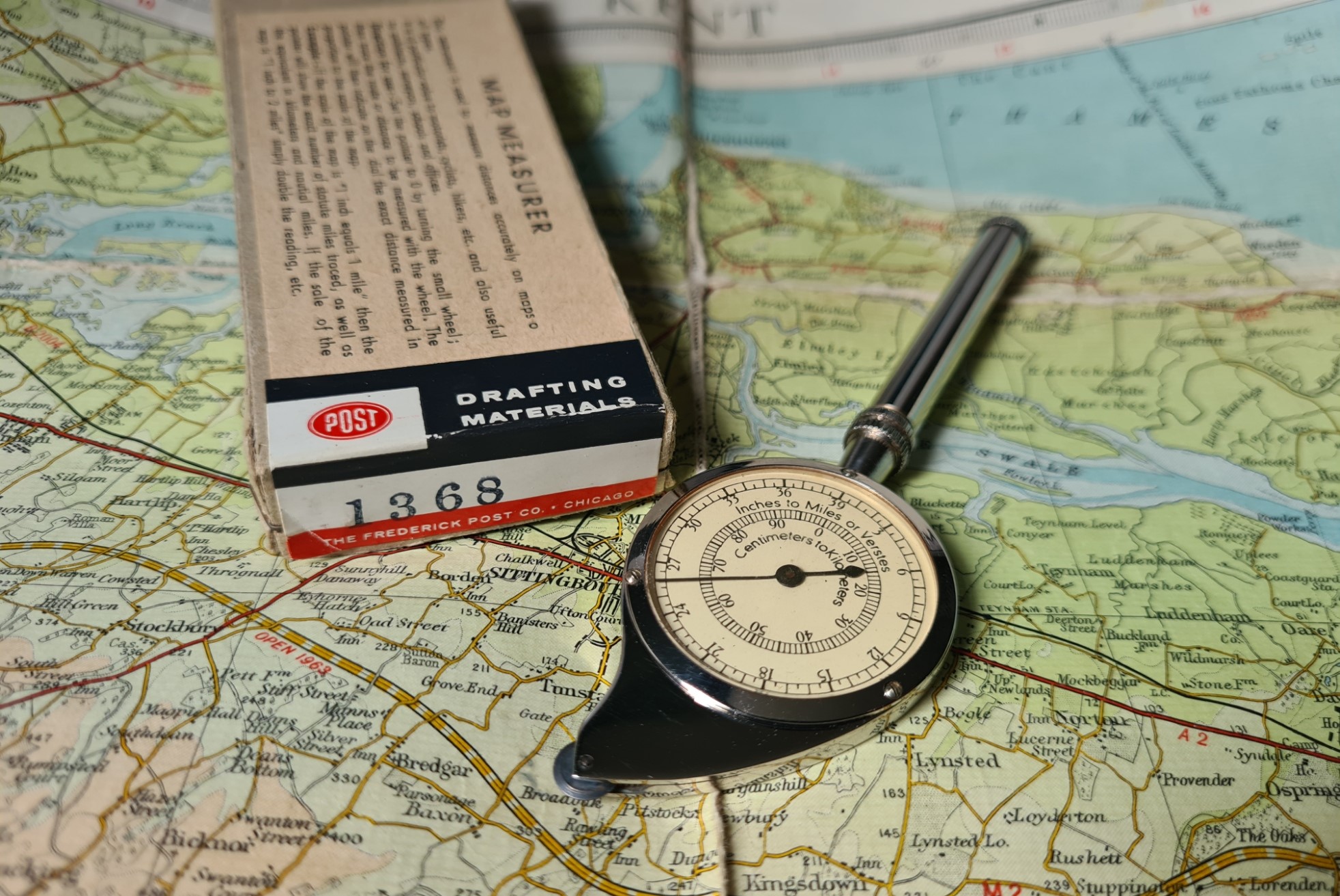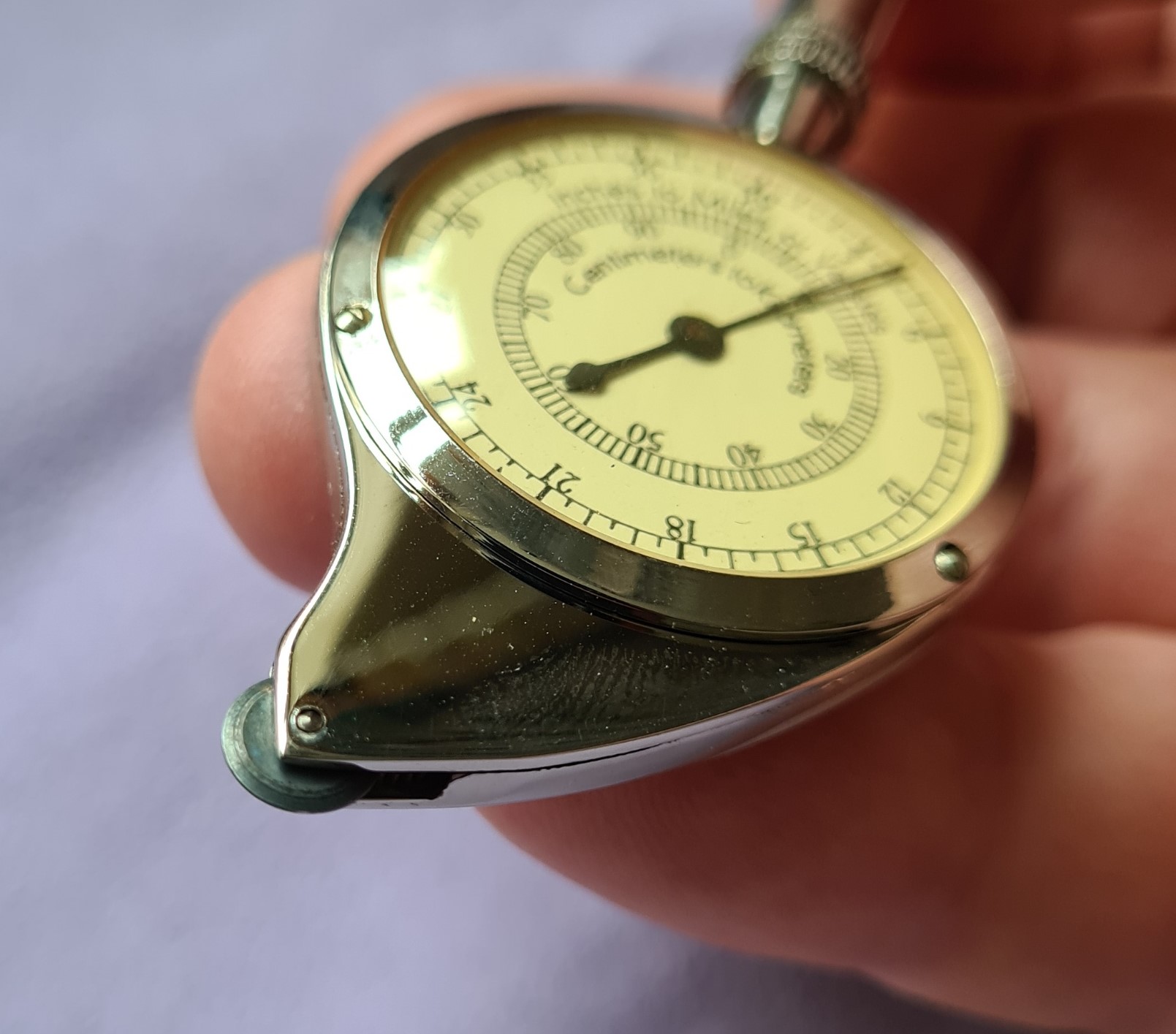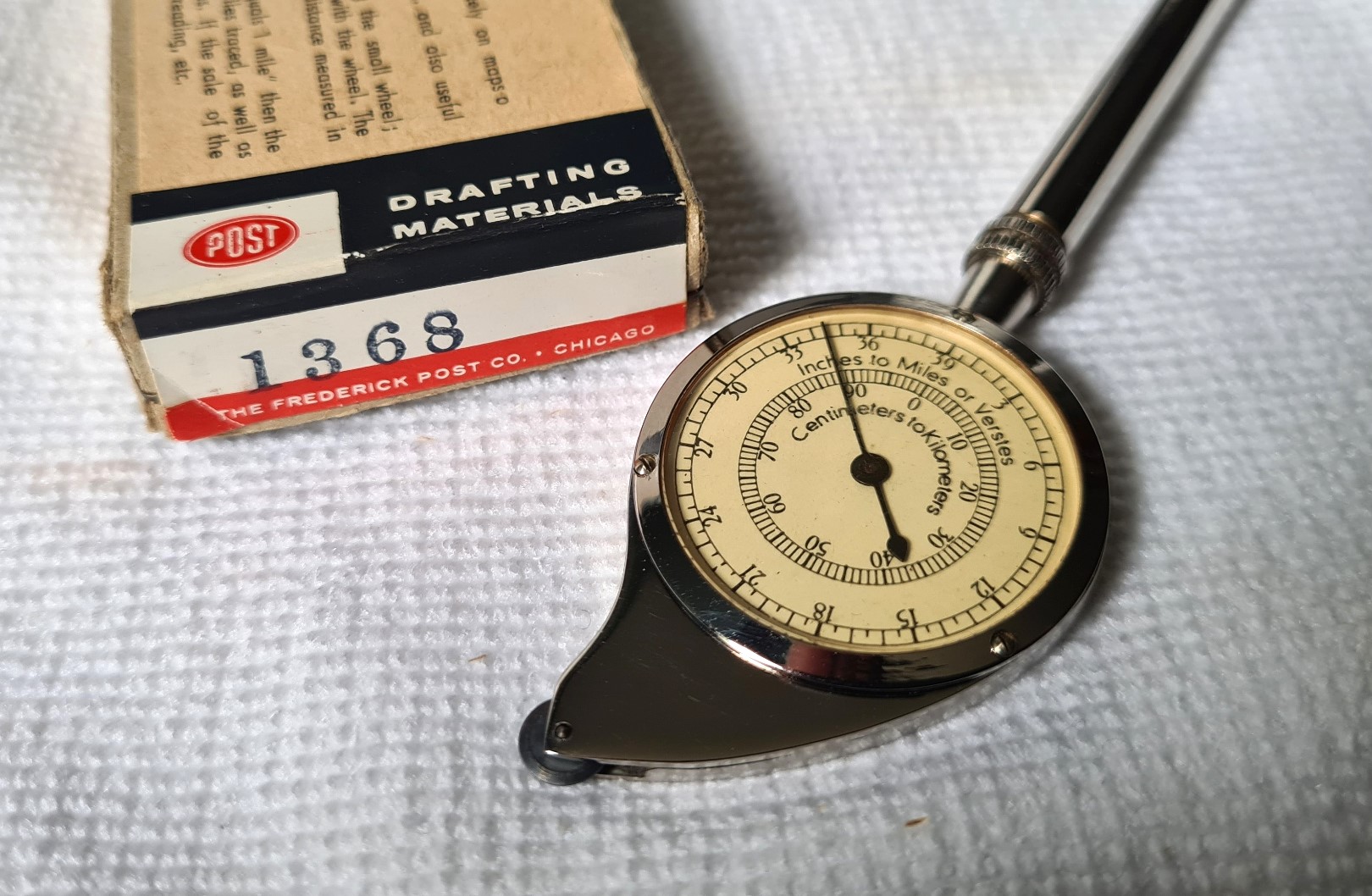“It is of particular value to motorists, cyclists, hikers, etc. and also useful to architects, surveyors, schools and offices”
The Frederick Post Co.
Frederick Post founded a firm selling drafting, engineering and surveying supplies in Chicago in 1890 and it continued to supply a wide range of products until the 1970s.
Almost all of ‘their’ products were rebranded items manufactured elsewhere. For example, their many slide rule models originated from American, German and Japanese manufacturers. It is not clear what factory manufactured this month’s map measure, however the rear of the case indicates that it was made in Germany sometime in the mid-twentieth century. As to whether it is a pre or post-war production measure, is a mystery.
The Frederick Post Map Measurer model 1368 has a nickel plated steel case and handle and has a lovely ‘swept’ design, where the tracking wheel at the base trails the measure in operation. This is an intuitive measure to use and once the locking wheel has been loosened at the top of the handle, the case rotates below the hand as you track a line on a map or drawing. It has a plain back to the case, other than the stamped words: “POST’S GERMANY”. ‘POST’S’ rather than ‘POST’ was a form of title that the company favoured more in the 1920s and 30s despite this being a measure introduced circa 1942. The crystal is fastened to the case by a nickel plated steel rim, held by three small screws.
The dial has two concentric scales, the inner for measuring Centimeters to Kilometers (the American spelling of the international Centimetres and Kilometres). This will measure up to 39 inches, with every three inches indicated in figures, plus half inch inter-increments. The outer scale converts Inches to Miles or Verstes (1 verste = 0.662879 mile / 3500 feet). Measuring 0-100, showing increments of 0, 10, 20, 30, 40, 50, 60, 70, 80, 90, with inter-increments of tenths. Despite the Soviet Union having adopted the metric system on 21 July 1925, this obsolete Russian measurement still appeared on many map measures, presumably because older maps remained in use. There is a single needle rotating the dial, driven by internal cogs, in turn driven by the tracking wheel. This wheel lacks any fine serrations to provide grip on a paper surface, instead relying on the instrument’s smooth internal action to prevent skating. The operator moves the handle by gripping the rotating central shaft on the handle. If the locking wheel is entirely unscrewed and removed, this central outer shaft can be slid off the inner handle by loosening a small grub screw on the side.
The measure came in a small two-piece card box. Both halves have copper stapled corners. There is a paper label fixed to the top face of the box, that continues down the right side of the box. This label has the corporate POST company colours of black, white and red. The side of the box showing both model number, “1368”, and “THE FREDERICK POST CO. CHICAGO” . The top label informs us that this measure is part of their “DRAFTING MATERIALS” line and gives instructions on how to use the measure.
The Frederick Post Company sold a small range of map measures over the years. Most, if not all of these, were rebranded instruments manufactured in Germany by various companies, including Aristo, Faber and Nestler. POST’s 1937 catalogue lists three map measure models: 1369 (costing $2.75), 1370 ($3.00) and 1370A ($6.75). Model 1371 joined the range in 1940. This month’s measure- Frederick Post model 1368, was first listed in their 1942 catalogue, described as a “New Item”, priced at $5.50 each. Map Measure models 1369 to 1371 were then listed as “temporarily discontinued”. This unavailability is unsurprising as there was a World War raging at the time (1939-45) that, as a very minimum, curtailed export of such instruments from Europe. The US entered World War II on 7 December 1941 following the Japanese bombing of Pearl Harbour. Three days later they were also at war with Germany and Italy after those two countries declared war against the US. It is strange that a German made measure was first listed in a POST product catalogue a year after the two countries engaged in conflict. This implies that a number of model 1368 measures must have been exported to the US in advance of that country entering the war and may explain the ‘POST’S’ company designation on the back of the case. I do not know if supply of this measure to Frederick Post from Germany continued following the war. If not, it is possible that this German made Post measure was available for a very brief period.
The trade mark ‘POST’ name, surrounded by an ellipse, on the box was registered in the Official Gazette of the United States Patent Office in March 1938, claiming use since January 1936. The registrant at that time was recorded as: Frederick Post Company, Illinois 3650, North Avondale Avenue, Chicago, Illinois. When registering their trade mark, Post stated that the branding would be used on a wide range of ‘Engineering and Draughting Supplies’, which included ‘Map Measures’. This form of their trade mark became prevalent from 1944 and remained in use until 1970 when the company became Teledyne Post and the Frederick Post brand name eventually vanished from use in 1972.
I do not know precisely where in Germany this measure was actually manufactured or which factory produced it. The rear of the Frederick Post model 1368 case is engraved/stamped “POST’S GERMANY”, indicating both the US retailer and the instruments’ country of manufacture. If this measure is a post 1936 product, the manufacturing situation is a little muddied. Following World War II, Germany was divided into four zones and in October 1949 these zones were consolidated in to two separate countries- West Germany, or more properly, the Federal Republic of Germany (FDR), and East Germany, or more properly, the German Democratic Republic (GDR). Following this, exported products manufactured in West Germany (FDR) almost always bore the phrase- “Made in W. Germany”, which is not what appears on the Post measure. This helpful differentiation was not followed by the authorities in East Germany and after 1949 many exported products from that country continued to be marked “Made in Germany” or simply “Germany” This remained the case until at least the early 1970s when the country of manufacture on exported goods changed to “Made in GDR”, or in Russian and Cyrillic script “Фарфор из ГДР “. Unfortunately I am unable to establish from which country this months measure came. While products manufactured in Germany following reunification in October 1990 will have the simpler phrase ‘Made in Germany’ or just ‘Germany’ on them, this date range can be discounted for our measure as the POST brand name vanished in the 1970s. This suggests that if the measure came from the area that was once West Germany, the Post 1368 measure shown here has extreme dates of 1936-1949 for availability in the US, but may be narrower than this. If it came from what was once known as East Germany, then an extreme date range of 1936-1970 is suggested for the measure though there will be a period within this where the instrument could not have been available to the US market due to the war and aftermath.
I have another example of this measure in my collection and it has subtle differences. None of which are particularly important. The dimensions of the two examples differ. The smaller is 110mm x 35mm x 7.9mm while the larger is only marginally larger: 112mm x 35mm x 8.15mm. The length difference is a result of a longer handle sleeve on one measure as the case dimensions remain the same, other than a domed crystal that stands very slightly more proud. The size of grub screw on the handle differs, the (presumed) earlier example has a quite tiny screw that is very difficult to replace once removed. The larger screw is much easier. The font is also different on the dial face. It is interesting that only one of the measures has the country of origin ‘GERMANY’ on the dial. Were paper dials replaced or simplified because the country the measure was being sold in was, or had recently been, at war with the country where it had been manufactured?
The Frederick Post model 1368 is a good map measure. It is well made and has a smooth operation and the trailing tracking wheel enables it to easily follow sinuosity on a map. That said, the scales are limited in practicality and it is little more than a historical artefact today. Though not rare, few of these measures survive today, however that may be more due to the locking screw on the handle being lost rather than any fault in manufacture.
Three Points of the Compass has looked at a few more Map Measurers in detail. Links to these can be found here.










